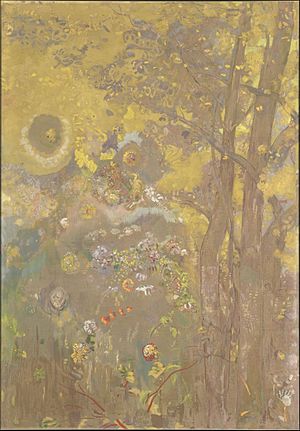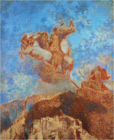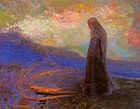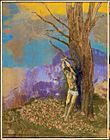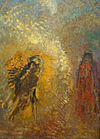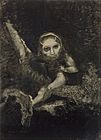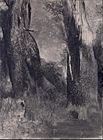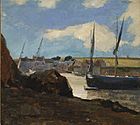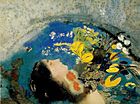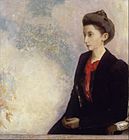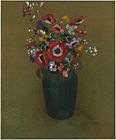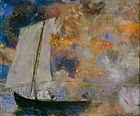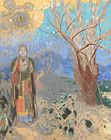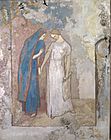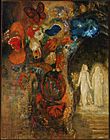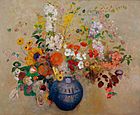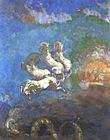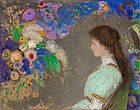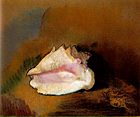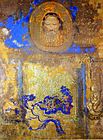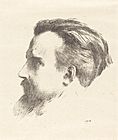Odilon Redon facts for kids
Quick facts for kids
Odilon Redon
|
|
|---|---|
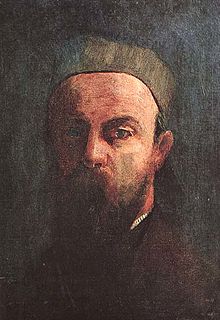
Self-Portrait, 1880, Musée d'Orsay
|
|
| Born |
Bertrand Redon
20 April 1840 Bordeaux, France
|
| Died | 6 July 1916 (aged 76) Paris, France
|
| Education | Atelier of Jean-Léon Gérôme |
| Known for | Painting, printmaking, drawing |
| Movement | Post-impressionism, symbolism |
Odilon Redon (born Bertrand Redon) was a French artist. He lived from April 20, 1840, to July 6, 1916. He is known for his unique style, often called Symbolism.
When he started his art career, Odilon Redon mostly used charcoal and a printing method called lithography. These artworks, often dark and mysterious, were known as his noirs (French for "blacks"). He became more famous after his drawings were mentioned in a popular book in 1884.
Later, in the 1890s, Redon started using pastels and oil paints. These became his favorite ways to create art. After 1900, he stopped making his noirs completely. He also became very interested in Hindu and Buddhist cultures, which started to appear in his paintings.
Today, Redon is perhaps best known for his dreamlike paintings from the early 1900s. These works were inspired by Japanese art and sometimes looked almost abstract. Many people see his art as an early example of Surrealism, a style that came later.
Contents
Early Life and Art Training
Odilon Redon was born in Bordeaux, France. His family was quite wealthy. He started drawing when he was a young child. At age ten, he even won a drawing prize at school.
When he was fifteen, he began to study drawing formally. However, his father wanted him to study architecture instead. Redon tried to get into a famous art school in Paris, the École des Beaux-Arts, but he didn't pass the exams. He did briefly study painting there in 1864. His younger brother, Gaston Redon, later became a well-known architect.
After returning to Bordeaux, Redon tried sculpting. He also learned how to make etchings and lithography prints from an artist named Rodolphe Bresdin. His art career was paused in 1870 when he had to serve in the army during the Franco-Prussian War. He served until the war ended in 1871.
Developing His Art Career
After the war, Redon moved to Paris. He went back to working mostly with charcoal and lithography. He called these imaginative, dark artworks his noirs. It wasn't until 1878 that his art started to get noticed. In 1879, he published his first collection of lithographs.
Redon remained somewhat unknown until 1884. That year, a popular novel called À rebours (Against Nature) was published by Joris-Karl Huysmans. The story featured a rich character who collected Redon's drawings, which helped make his work more famous.
In 1886, Redon showed his art alongside the Impressionists in their last exhibition. He also started showing his work in Brussels with a group called Les XX.
In the 1890s, Redon began to use pastels and oil paints. He stopped making his noirs completely after 1900. In 1899, he exhibited with another art group called Les Nabis.
Redon became very interested in Hindu and Buddhist cultures. The figure of the Buddha started to appear more and more in his art. He was also influenced by Japonisme, which is the study of Japanese art. You can see this in paintings like The Death of the Buddha (around 1899) and The Buddha (1906).
Important Artworks and Commissions
Baron Robert de Domecy asked Redon in 1899 to create 17 large decorative panels. These were for the dining room of his home, the Château de Domecy-sur-le-Vault in France. Redon had made big decorative works before, but these panels were his most daring. They showed a shift from simply decorating to more abstract painting.
The landscapes in these panels don't show a real place. Instead, they feature details of trees, branches, and flowers against an endless background. Redon mostly used colors like yellow, grey, brown, and light blue. The way he used colors and the rectangular shape of the panels (some were 2.5 meters tall!) show the influence of Japanese folding screens, called byōbu. Fifteen of these panels are now in the Musée d'Orsay in Paris.
Baron Domecy also asked Redon to paint portraits of his wife and daughter. Two of these portraits are also in the Musée d'Orsay and the Getty Museum in California.
Awards and Recognition
In 1903, Redon was given the Legion of Honour, a high award in France.
His art became even more popular when a catalog of his etchings and lithographs was published in 1913. That same year, a large number of his works were shown at the important International Exhibition of Modern Art in New York City. This helped introduce his art to many people in the United States.
Personal Life and Death
When he was 40, Odilon Redon married Camille Falte. They had a son named Arï Redon, who was also an artist. Arï was often the subject of his father's portraits when he was a child.
Odilon Redon passed away on July 6, 1916, in Paris.
Legacy and Exhibitions
Because of his use of bright colors and imaginative subjects, Redon is seen as an artist who helped pave the way for later art movements like Dadaism and Surrealism. The Surrealist artist André Masson said that Redon's colorful flower pastels showed "endless possibilities" for art, moving beyond just copying nature.
Many years after his death, museums around the world have continued to show Redon's work.
- In 2005, the Museum of Modern Art in New York held a big show called "Beyond The Visible." It featured over 100 of his paintings, drawings, and prints.
- In 2007, the Schirn Kunsthalle Frankfurt in Germany presented "As in a Dream," with more than 200 of his artworks.
- The Grand Palais in Paris had a large exhibition of his art in 2011.
- The Fondation Beyeler in Switzerland showed his work in 2014.
- The Kröller-Müller Museum in the Netherlands had an exhibition in 2018. It focused on how literature and music influenced Redon's life and art.
Gallery
-
Caliban, 1881 (Musée d'Orsay)
-
Lady of the Flowers, c. 1890–1895 (Honolulu Museum of Art)
-
Baroness Robert de Domecy, 1900 (Musée d'Orsay)
-
Flower Clouds, 1903 (The Art Institute of Chicago)
-
Portrait of Violette Heymann, 1910 (Cleveland Museum of Art)
-
Saint Sebastian, 1910–1912, (National Gallery of Art)
-
Les Anemones (Still Life with Anemones), c. 1900–1910 (Minneapolis Institute of Art)
See also
 In Spanish: Odilon Redon para niños
In Spanish: Odilon Redon para niños


